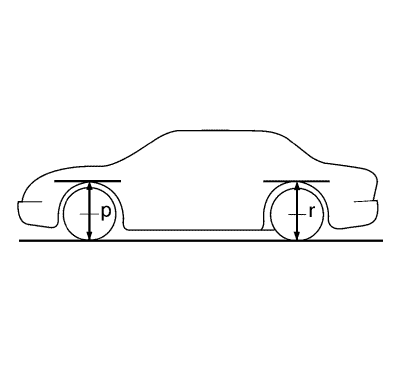Trim Height Inspection
Trim Height Measurement
Trim height is a predetermined measurement relating to vehicle ride height. Incorrect trim heights can cause the vehicle to bottom out over bumps, damage to the suspension components and symptoms similar to wheel alignment problems. Check the trim heights when diagnosing suspension concerns and before checking the wheel alignment.
Perform the following before measuring the trim heights:
| • | Check the fuel level. Add additional weight if necessary to simulate a full tank. |
| • | Make sure the passenger and rear compartments are empty, except tor the spare tyre. |
| • | Make sure the vehicle is on a flat and level surface, such as an alignment rack. |
| • | Check that all the vehicle doors are securely closed. |
| • | Check that the vehicle bonnet and rear deck lids are securely closed. |
| • | Check for installed after market accessories or modifications that could affect trim height measurement. |
Measuring the P and R Dimension

Note: All dimensions are measured vertical to the ground. Trim height should be within ±10 mm (±0.39 in) to be considered correct.
Use the following procedure to check the P and R dimensions:
| • | Lift the front bumper of the vehicle up about 38 mm (1.5 in). |
| • | Gently remove your hands and let the vehicle settle. |
| • | Repeat this operation 2 more times for a total of 3. |
| • | P height is measured vertically from the ground to the bottom lip of the wheel opening through the centreline of the front wheel. |
| • | Push the front bumper of the vehicle down about 38 mm (1.5 in). |
| • | Gently remove your hands and let the vehicle settle down. |
| • | Repeat this operation 2 more times for a total of 3. |
| • | Measure the P height as in step 4. |
| • | The true P height measurement is the average of the measurements taken in step 4 and 8. |
| • | Repeat the above steps on the rear of the vehicle for the R heights. |
| © Copyright Chevrolet. All rights reserved |
